Introduction
Physical therapy in Leslie, Mason and Charlotte for Hip
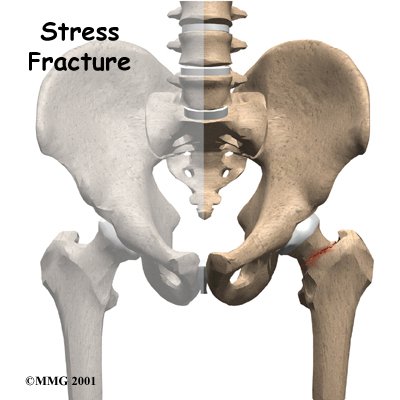
Welcome to Sam's Physical Therapy's patient resource about Stress Fracture of the Hip.
Stress fractures of the hip once most commonly affected military personnel who marched and ran day after day. Today, stress fractures of the hip are more common in athletes, especially distance runners.
There are two types of stress fractures. Insufficiency fractures are breaks in abnormal bone under normal force. Fatigue fractures are breaks in normal bone that has been put under extreme force. Fatigue fractures are usually caused by new, strenuous, very repetitive activities, such as marching or distance running. Most stress fractures of the hip are fatigue fractures. The stress fractures this article refers to are fatigue fractures.
This guide will help you understand:
- how a stress fracture develops
- how doctors diagnose the condition
- what treatment options are available
#testimonialslist|kind:all|display:slider|orderby:type|filter_utags_names:Hip Pain|limit:15|heading:Hear from some of our patients who we treated for *Hip Pain*#
Anatomy
The femur is the large bone in the thigh. The ball-shaped head of the femur fits into a socket in the pelvis, called the acetabulum. When a stress fracture occurs in the , it usually involves the femoral neck, the short section of bone that connects the head of the femur to the main shaft of the bone. The femoral neck is a thinner part of the femur. Stress fractures are hairline cracks in the bone that can grow larger over time if not treated properly.
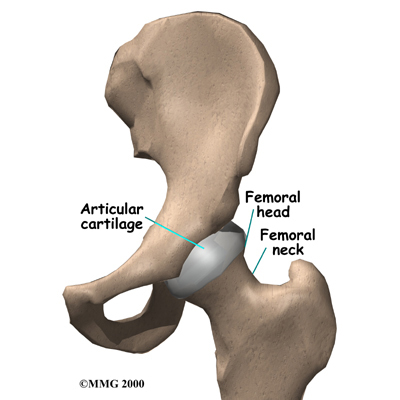
The femoral neck has to withstand extreme force even during normal activities, such as standing still. The normal contraction of muscles during walking makes this stress even higher. Running triples the stress on the femoral neck.
Surgeons put fatigue fractures of the femoral neck into . Compression fractures occur on the underside of the femoral neck. Tension fractures occur on the upper side of the bone and can cause more problems than fractures on the underside of the femoral neck. In displaced fractures, the bone cracks all the way through, and the two bones no longer line up correctly.
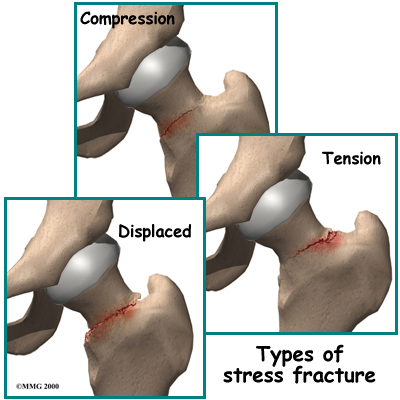
A displaced stress fracture is a very serious problem in a young adult because it may lead to damage to the blood vessels going into the upper end of the hip bone. This can cause a very serious complication known as avascular necrosis (AVN) of the hip.
Related Document: Sam's Physical Therapy's Guide to Avascular Necrosis of the Hip
Patients with fatigue stress fractures of the hip are also likely to have muscle and tendon injuries and swelling of the synovial lining (the lubricated lining) of the hip joint.
Stress fractures can also happen in the shaft of the femur bone, the , and the pelvis bone. The greater trochanter is a large bump below the neck of the femur. The buttock muscles that move the hip connect to this part of the femur.
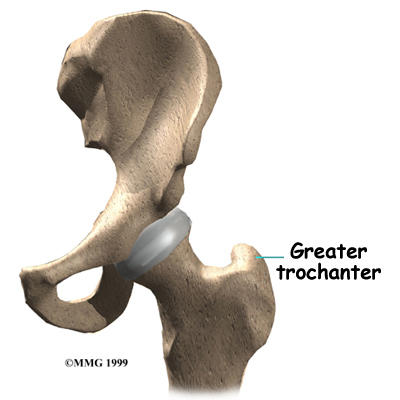
Related Document: Sam's Physical Therapy's Guide to Hip Anatomy
Causes
Doctors think that putting extreme stress on the bone over and over again causes stress fractures of the hip. Think of how you can break a metal paper clip by bending it back and forth repeatedly.
Bones can usually adapt to repetitive stress, and any change in the function of a bone causes it to change the way it is built. This is how small bumps and ridges form on bones. The tendons pull on these areas, and the bone adapts by building up. This is normal. But extreme stress repeated too often can overwhelm the bone's ability to adapt. This is especially true when someone suddenly begins a new, strenuous, repetitive activity such as running.
Fatigue fractures are related to both the amount of exercise and how fast people increase their exercise program. The more people run or march, the more likely they are to develop a fatigue fracture. Research suggests that most athletes who develop stress fractures have been training for at least two years, six or more times a week. A stress fracture is more likely to occur after an increase in how far, how often, and how hard a person goes.
Women are up to 10 times more likely to develop fatigue fractures than men. The reasons for this are unclear. Hormonal changes may make women athletes' bones more likely to fracture. Eating disorders, which are more common in women athletes, may also make bones more likely to fracture.
Age also makes stress fractures of the hip more likely. This is thought to be due to declining levels of physical fitness more than age.
Symptoms
Most patients with stress fractures of the hip feel pain in the front of the groin while standing and moving. Rest usually makes the pain go away. Patients may limp. Strenuous activities, such as running and climbing stairs, may be so painful that the patient must stop doing them.
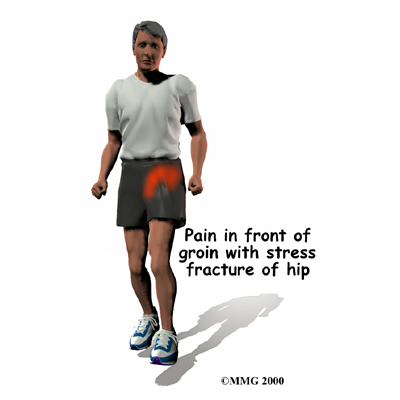
Diagnosis
When you visit Sam's Physical Therapy, our physical therapist will take a detailed medical history and ask many questions about your activities and exercise. We will also physically examine the painful hip. One of our main goals will be to determine if other problems, such as muscle or tendon injuries, are causing some or all of your pain.
Some patients may be referred to a doctor for further diagnosis. Once your diagnostic examination is complete, the physical therapists at Sam's Physical Therapy have treatment options that will help speed your recovery, so that you can more quickly return to your active lifestyle.
Sam's Physical Therapy provides services for physical therapy in Leslie, Mason and Charlotte.
Our Treatment
The treatment you receive will depend on the type of fracture you have.
Non-surgical Rehabilitation
Nonsurgical treatment for compression-type fatigue fractures is typically tried before surgery is considered. Your Sam's Physical Therapy physical therapist will direct you to stay off the affected leg, using crutches if necessary, and rest the hip for at least four to six weeks.
Treating a stress fracture without surgery will require you to strictly avoid putting weight down on the foot of the injured leg when standing or walking. When the bones begin to heal, you'll be able to put more weight on your foot as you stand and walk.
We can help manage your initial pain with hot and cold treatments. Patients may also want to consult with their doctor or pharmacist regarding the use of pain relief or anti-inflammatory medication. Our physical therapist can direct your rehabilitation to help you improve strength and flexibility in the hip and to make sure you are able to safely resume your activities. With care, these fractures tend to heal without surgical intervention.
Post-surgical Rehabilitation
Recovery after surgery for hip fracture depends on the type of procedure used. The aim of most surgical procedures for a fractured hip is to help people get moving and walking as quickly as possible. This helps them avoid dangerous complications that can happen from being immobilized, such as pneumonia, blood clots, joint stiffness, and pain.
Once you are able to leave the house, visits to Sam's Physical Therapy may be needed for patients who are still having problems walking or who need to get back to physically heavy work or activities.
At Sam's Physical Therapy, our goal is to help you keep your pain under control, improve your range of motion, and maximize strength and control in your ankle. When your recovery is well under way, regular visits to our office will end. We will continue to be a resource, but you will be in charge of doing your exercises as part of an ongoing home program.
Sam's Physical Therapy provides services for physical therapy in Leslie, Mason and Charlotte.
Surgery
In some patients with a fracture under the femoral neck, MRIs and other imaging tests sometimes show an unstable fracture that needs to be surgically fixed.
The surgical procedure is the same whether the stress fracture is stable or there is only a slight displacement of the bones. If your surgeon recommends surgery for a stress fracture of the hip, several large metal screws will be inserted through the femoral neck to hold the fractured bones in place while the fracture heals.
To perform this procedure, a small incision is made on the side of the upper thigh. With the help of a special X-ray machine called a fluoroscope, the surgeon can insert the metal screws into the proper position while watching the X-ray image on a TV screen.
When the ends of the bones show a large displacement, surgeons aren't in total agreement about which surgery is best. Most surgeons agree that younger, active patients benefit if surgery is done to save the femoral head. This method also uses screws to connect the two sections of bone.

To avoid problems with AVN, other surgeons feel that older, less active patients should have part or all of the hip joint replaced. If the socket of the joint is healthy, the surgeon may decide to replace only the ball portion of the joint, a procedure called hemiarthroplasty.
Related Document: Sam's Physical Therapy's Guide to Hemiarthroplasty of the Hip
The procedure to replace both the ball and the socket with an artificial joint is called total hip arthroplasty.
Related Document: Sam's Physical Therapy's Guide to Artificial Joint Replacement of the Hip
Portions of this document copyright MMG, LLC.





















